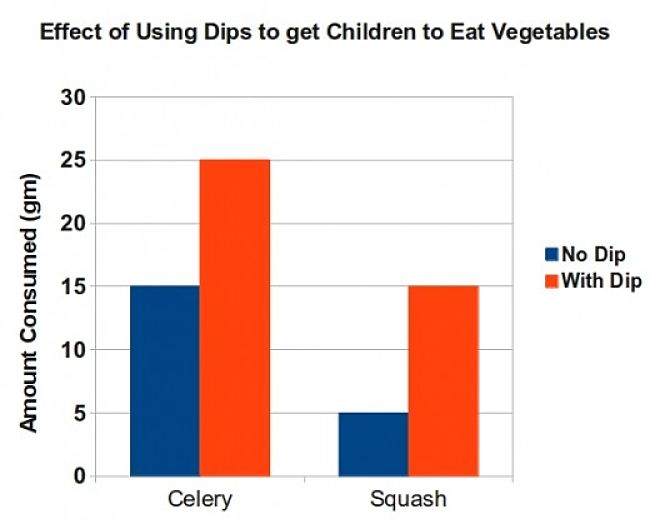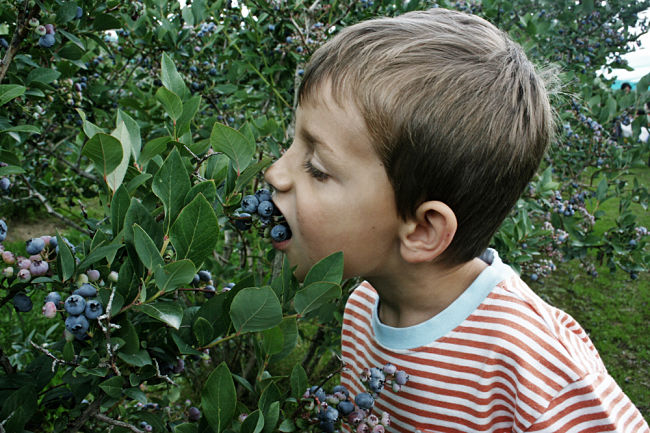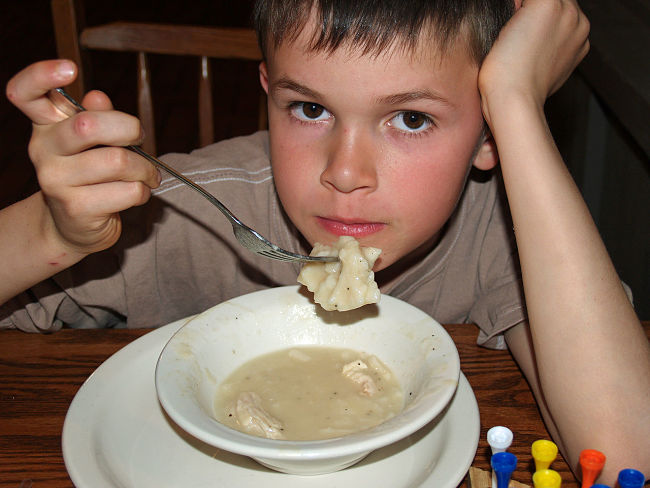Get Children Eating Vegetables by Using Healthy Flavored Dips Kids Love to Eat
Most parents have a terrible time getting their preschool children to eat vegetables regularly and to try new vegetable dishes. This means that many kids fall well short of the 1-2 cups of vegetables recommended for children aged from three to five years by health authorities around the world.
Parents try various tricks to 'hide' pureed vegetables in pasta sauce and all sorts of incentives and iron will-busters with varying success.
Well now there is a new way that has been proven to work through research studies: adding chopped vegetables to herb flavored and spice flavored reduced-fat dips (plain, garlic, herb, pizza, and ranch).
The studies showed that using dips increased vegetable consumption by two to three times, compared with offering plain vegetables.
It also was effective in getting children to try new vegetables and to accept vegetables that they had previously rejected.
See how to do this and other tricks to try to get children to eat more vegetables.

Research Study Results on Effectiveness of Dips in Increasing Vegetable Consumption
The children were first asked to taste and rate six different vegetables, using pictures of a smiling face, frowns, rejections and neutral responses to rate their likes and dislikes for a range of vegetables. The ones included were: carrots, celery, red bell peppers cucumbers, green beans and yellow squash.
A series of experiments were conducted.
- Three vegetables were chosen for each child: one they disliked, one they liked, and one they refused to even taste. The children were the offered these three vegetables in a plain reduced-fat dip and their favorite herb-flavored dip. The outcome was that the spicy and herb flavored dips were more effective than the plain dip. Children offered the vegetable by itself, were 300% more likely to reject it, than when offered the vegetable in a herb dip.
- The children's liking of yellow squash and celery was rated, and total consumption was measured when offered with their favorite dip and with vegetables alone. As shown in the image, children ate significantly more yellow squash and celery when offered with a reduced-fat herb dip than when alone.
The conclusion from the study was that putting vegetables in reduced-fat dips worked well in getting children to eat more vegetables. The was especially effective when the vegetables were offered in dips the children liked and which had pronounced flavors such as spice and herb. Flavored dips were much more effective than plain dips.
This strategy was effective in getting infants to like, accept, and consume vegetables, including those which the children had previously shown they disliked or which they rejected and would not taste.
Adopting these tactics could help the 90% of children aged 4-8 years in the US who don't get their recommended daily allowance of vegetables.
Even worse, it has been shown the about 30% of children get no vegetable whatsoever on a normal day.
Children are remarkably fussy about eating vegetables and this tactic should help.
Other studies have shown that with patience and perseverance, including repeated tries over and over again, with vegetables offered as part of a normal meal could eventually succeed with some kids. The advantage of using dips is that it encourages the children to taste the vegetable. This is a major hurdle to overcome. Also the children get used to the taste of the vegetable. The amount added to the dip need not be very large at first.

Other Ways to Get Toddlers to Eat and Try New Vegetables
The simplest way is to add vegetable purees to various dishes, such as:
- mixing pureed yellow squash or cauliflower with mashed potatoes
- adding vegetable juice or blended vegetables to soups
- blending vegetables such as carrots, spinach, zucchini or beets and add them to pasta sauce or meat loaf dishes or even burgers.
- adding pureed broccoli to scrabbled eggs. Children love the color varieties
Vegetables can be added to a wide variety of baked goods. Frozen spinach, shredded zucchini or carrots can be added to muffin batters and breads. Shredded beets can be added to chocolate cake, cooked pumpkin can be added to pancake and other batters.
Make a huge variety of vegetable and fruit cocktails and smoothies. Fruit and vegetable juices can be frozen and made into homemade ice blocks.
Serve peanut butter or cheese spread in celery sticks. Add some raisins dotted along the top for extra interest.
What are the Healthiest Vegetables
The choice of vegetables very much depends on what you are looking for: high fiber, high protein, low fat and low calories. There are many articles that include charts of the healthiest vegetables for various criteria. The best overall healthiest vegetables are:
- Collard leaves and stems
- Cabbage, shredded
- Beet greens
- Kohlrabi
- Asparagus
- Tomato, ripe red
- Mustard greens
- Spinach, raw
- Fennel
- Yellow snap bean
- Turnip greens
- Sweet green pepper
- Eggplant
Related Articles about Food for Children
=> How to Make Toffee Apples, Candy Apples and Easy to Make Toffee Recipe
=> Are Snack Bars Healthy - Cereal, Protein, Fruits, Granola - Myths and Facts
=> Best Homemade Marshmallow Recipe Collection for Slices and Desserts
=> Smart Healthy Snacks - Ideas, Tips and Best Food Choices
=> Dark Chocolate is a Healthy Choice with Many Proven Health Benefits
=> Easy Chocolate Truffles Recipes with Liqueurs, Mint, Nuts and Spices
=> Chocolate Truffles Recipes with Liqueurs, Mint, Nuts and Spices
=> Dutch Chocolate Pastry Balls Recipe, Cream Filled


